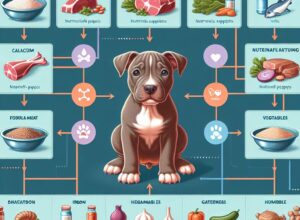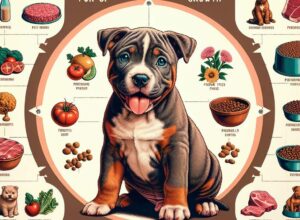
When it comes to feeding pitbull puppies, we want to ensure they’re getting the best nutrition possible. That’s why crafting homemade raw dog food can be such a rewarding endeavor. Not only does it allow us to control the quality of ingredients, but it also caters to our pups’ ancestral dietary needs. Let’s dive into how you can create a feast for your pitbull puppy that’s both delicious and nutritious, starting with some great recipes you can get started with right now.
Homemade Recipe Sampler
These recipes are designed to give your pitbull puppy a balanced diet, full of all the nutrients they need to thrive. Remember to introduce new foods gradually and watch for any signs of allergies or sensitivities.
Beef and Organ Blend for Muscle Health
This protein-packed recipe is perfect for building strong muscles in your growing pitbull puppy. Here’s what you’ll need:
Ingredients:
– 2 pounds of ground beef (85% lean)
– 1/2 pound of beef liver
– 1/2 pound of beef kidney
– 1 cup of chopped spinach
– 2 whole eggs (including shells for calcium)
– 1/2 cup of blueberries
Instructions:
1. Mix ground beef, liver, and kidney in a large bowl.
2. Finely chop the spinach and crush the eggshells into a fine powder.
3. Add the spinach, whole eggs, and blueberries to the meat mixture.
4. Combine all ingredients thoroughly and portion into meal-sized servings.
5. Store in the fridge or freezer as outlined above.
Offer this blend a few times a week to keep those muscles growing strong.
Chicken and Fish Fusion for Skin and Coat
Omega-3 fatty acids are essential for a shiny coat and healthy skin. This recipe combines chicken and fish to provide those vital nutrients.
Ingredients:
– 2 pounds of ground chicken
– 1 pound of sardines or mackerel, chopped
– 1 cup of pureed pumpkin
– 1/4 cup of ground flaxseed
– 1 apple, cored and chopped (no seeds)
Instructions:
1. Combine ground chicken and chopped fish in a large bowl.
2. Stir in the pureed pumpkin and ground flaxseed.
3. Mix in the chopped apple for a hint of sweetness.
4. Portion the mixture into meal-sized servings and store properly.
Feed this fusion meal regularly to maintain a lustrous coat and supple skin.
Veggie Boost: Canine Superfood Mix
Vegetables are a powerhouse of vitamins and minerals. This veggie boost is a great way to ensure your pitbull puppy is getting a rainbow of nutrients.
Ingredients:
– 1 cup of chopped kale
– 1 cup of chopped carrots
– 1/2 cup of chopped blueberries
– 1/4 cup of chopped cranberries
– 1/2 cup of cooked quinoa (for a little bit of healthy carbs)
Instructions:
1. Steam the kale and carrots until slightly soft.
2. Mix the steamed veggies with blueberries, cranberries, and cooked quinoa.
3. Let the mixture cool down before serving.
4. This can be added as a topper to your puppy’s regular meals or fed alone as a light meal.
Incorporate this mix into your puppy’s diet a few times a week for an extra nutrient kick.
Pitbull Puppies Thrive on Raw
It’s crucial to understand why a raw diet can be beneficial for your pitbull puppy. These little powerhouses require a diet rich in protein to support their rapid growth and high energy levels. A raw diet mimics what their ancestors would have eaten in the wild, providing a natural source of nutrients that are easily digestible for your pup.
Why Opt for a Homemade Raw Diet?
Choosing to prepare your pitbull puppy’s meals at home comes with a slew of advantages. Firstly, you have full transparency over what goes into their food, ensuring they’re not consuming any hidden fillers or preservatives found in some commercial dog foods. Secondly, a raw diet can lead to improved digestion, healthier skin and coat, and more stable energy levels. Plus, it’s a labor of love that strengthens the bond between you and your puppy.
However, it’s not a decision to be taken lightly. Preparing a raw diet requires careful planning to ensure all nutritional needs are met. But don’t worry, I’ll guide you through each step to make it as straightforward as possible.
Understanding Your Pitbull Puppy’s Nutritional Needs
As we embark on this raw feeding journey, it’s essential to grasp the nutritional needs of your pitbull puppy. These robust dogs need a diet that’s high in protein and fat to fuel their muscular build and vivacious spirit. Carbohydrates, while not a primary energy source in a raw diet, still play a role in providing dietary fiber and essential nutrients when sourced from vegetables and fruits.
Here’s what you need to keep in mind:
- Protein is the cornerstone of your puppy’s diet and should come from high-quality animal sources.
- Fats are crucial for energy and support healthy skin and coat; they should be well-balanced between omega-3 and omega-6 fatty acids.
- Carbohydrates should be limited but included in the form of digestible vegetables and fruits to provide fiber and essential vitamins.
- Calcium and phosphorus are vital for bone development and must be present in the correct ratios.
- Vitamins and minerals should be naturally sourced from food, but some supplementation may be necessary to prevent deficiencies.
With these guidelines in place, you’ll be well on your way to creating meals that will support your pitbull puppy’s growth and development.
Selecting the Right Proteins: A Guide
Protein is the building block of a strong and healthy pitbull puppy. It’s what helps them grow and keeps their muscles lean and powerful. When it comes to choosing proteins, variety is key. You’ll want to rotate between different types of meat to provide a spectrum of nutrients. Think beef, chicken, turkey, and fish like sardines or salmon for those omega-3s. Organ meats are also a powerhouse of nutrition, so don’t skip on the liver, kidneys, and heart. Remember, fresh and high-quality is the name of the game.
Incorporating Fruits and Vegetables
While meat takes center stage in a raw diet, fruits and vegetables play a supporting role that’s just as important. They’re packed with vitamins, minerals, and fiber that aid digestion and boost the immune system. But not all veggies and fruits are created equal in the eyes of a dog. Stick to dog-safe options like carrots, blueberries, and spinach. Always introduce new items slowly and in moderation to avoid any tummy troubles.
- Carrots: Crunchy and good for dental health.
- Blueberries: Antioxidant-rich and perfect for a treat.
- Spinach: Loaded with iron and vitamins.
- Pumpkin: Great for digestion and a source of fiber.
- Apples: A sweet treat, but remember to remove the core and seeds.
Blend or finely chop these goodies to help your pup digest them better, and mix them into their meaty meals.
Benefits of Adding Supplementation
Even the best homemade diets might have gaps, and that’s where supplements come in. They’re the safety net that ensures your pitbull puppy gets everything they need. A good start is a balanced omega-3 supplement to promote a shiny coat and healthy skin. You might also consider adding a vitamin and mineral blend designed for raw diets. And for those growing bones, a proper calcium source is crucial, especially if you’re not feeding raw bones.
- Omega-3 Supplements: For skin and coat health.
- Vitamin and Mineral Blends: To fill any dietary gaps.
- Calcium: Essential for bone development, especially if bones aren’t part of the diet.
- Probiotics: To support gut health and digestion.
Always consult with your vet before adding any supplements to your puppy’s diet to ensure they’re necessary and given in the correct dosage.
Preparation and Storage: Ensuring Safety and Freshness
When preparing raw meals for your pitbull puppy, cleanliness is paramount. You’re handling raw meat, so treat it as you would when cooking for your family. Use separate cutting boards for meat and vegetables, wash your hands thoroughly, and disinfect all surfaces after use. This attention to detail will help keep you and your pup safe from bacterial contamination.
Minimizing Contamination Risks
Contamination is a real concern with raw diets. To minimize risks, source your meat from reputable suppliers, and opt for human-grade options whenever possible. Freeze meat for 24-48 hours before use to kill off any parasites. Thaw meals in the fridge, not on the counter, to keep bacteria at bay. And always, always wash your hands after handling raw food.
- Source high-quality, human-grade meat.
- Freeze meat to kill parasites.
- Thaw meals in the refrigerator.
- Practice good hygiene and kitchen cleanliness.
By following these simple steps, you’ll ensure your pitbull puppy’s meals are not just nutritious, but also safe for them to enjoy.
Portioning and Storage Best Practices
Getting the portion sizes right is crucial for your pitbull puppy’s growth. Too little and they won’t get enough energy; too much and you risk obesity. A general rule of thumb is to feed puppies about 2-3% of their expected adult weight, spread over multiple meals a day. But remember, every puppy is different, so adjust as needed based on their activity level and growth.
For storage, think of raw dog food as you would leftovers. Use airtight containers and refrigerate what your pup will eat within a few days. Freeze the rest in portion-sized containers or bags. Label everything with the date it was made, so you know what to use first. This keeps the food fresh and makes mealtime a breeze.
- Calculate portions based on expected adult weight.
- Adjust meal sizes according to your puppy’s growth and energy needs.
- Use airtight containers to store food in the fridge or freezer.
- Label containers with the preparation date to ensure freshness.
Now that you’ve got the basics down, let’s move on to some mouth-watering recipes your pitbull puppy will love.
Feeding Guidelines for Growing Puppies
Feeding your pitbull puppy a raw diet isn’t just about the ingredients; it’s also about how much and how often. Growing puppies have different nutritional needs at different stages, and it’s vital to adjust their diet accordingly. A common rule is that puppies should eat about 2-3% of their expected adult body weight per day, divided into multiple meals. As they grow, their portion sizes will grow too, and so will the time between meals.
Transitioning to Raw Food: A Step-by-Step Process
Switching your puppy to a raw diet should be a gradual process. Start by mixing a small amount of raw food with their current food and gradually increase the raw portion over the course of a week or two. This slow transition helps prevent digestive upset and allows your puppy’s system to adjust. Here’s a simple transition schedule:
- Day 1-3: Serve 75% old food with 25% new raw food.
- Day 4-6: Transition to a 50/50 mix of old food and raw food.
- Day 7-9: Serve 25% old food with 75% new raw food.
- Day 10: Move to 100% raw food, if your puppy is tolerating it well.
Keep an eye on your puppy’s stools and overall health during this transition. If you notice any digestive issues, slow down the transition process.
Portion Size Calculation Based on Puppy’s Weight
Calculating the right portion size for your pitbull puppy is easier than it sounds. First, estimate their expected adult weight based on their breed and parents’ size. Then, feed them 2-3% of that weight each day. For example, if you expect your pitbull to be 50 pounds as an adult, they should eat about 1 to 1.5 pounds of food per day. Divide this amount into the number of meals you’re serving – usually three to four meals for puppies.
Remember, these are just guidelines. Active puppies might need more food, while more sedentary ones might need less. Keep an eye on their body condition and adjust portions as needed.
Monitoring Your Pitbull Puppy’s Health
As you feed your pitbull puppy a raw diet, it’s crucial to monitor their health closely. This means regular check-ups with the vet, watching for changes in their energy levels, and keeping an eye on their coat and stool quality. A healthy puppy should have a shiny coat, clear eyes, and firm stools. If something seems off, don’t hesitate to consult your vet.
Identifying Allergies and Dietary Sensitivities
Allergies and sensitivities can occur with any diet, and raw feeding is no exception. Signs of food allergies in puppies include itchy skin, ear infections, and digestive upset. If you suspect your puppy has a food allergy, work with your vet to identify the culprit. This might involve an elimination diet, where you remove one ingredient at a time to see if symptoms improve.
Remember, every puppy is unique, and what works for one may not work for another. Pay attention to how your puppy responds to different foods and adjust their diet accordingly. With a little patience and observation, you can tailor a raw diet that keeps your pitbull puppy healthy and happy.
Consulting with a Vet: Diet Approval and Adjustments
Now, it’s not just about what you think is best for your pitbull puppy; your vet’s input is invaluable. Before you embark on a homemade raw diet, have a chat with your vet. They can provide guidance on nutritional balance and help you understand your puppy’s specific needs. As your puppy grows, their dietary requirements will change, and your vet can help you make the necessary adjustments. Regular check-ins will ensure your pup is on track for a healthy life.
It’s also wise to get a professional opinion if your puppy shows any signs of health issues. Your vet can tell if these are diet-related and suggest tweaks to their meals. After all, a healthy pup is a happy pup, and a happy pup means a happy you.
FAQ
Got questions? You’re not alone. Here are some of the most common queries I hear from pet parents about raw feeding:
How do I start my pitbull puppy on a raw food diet?
Starting your puppy on a raw diet is a process. Begin by introducing raw food gradually. Mix it with their current food, slowly increasing the raw portion over a week or two. Keep an eye on their digestion and energy levels. If they’re doing well, you can gradually phase out the old food completely. And remember, patience is key!
What are the best sources of protein for my pitbull puppy’s diet?
Quality protein is vital for your pitbull puppy. Think whole meats like beef, chicken, and turkey. Don’t forget fish for those omega-3 fatty acids. And organ meats like liver and kidney are nutritional goldmines. Rotate these proteins to give your pup a variety of nutrients. Freshness is crucial, so choose the best quality you can afford.



